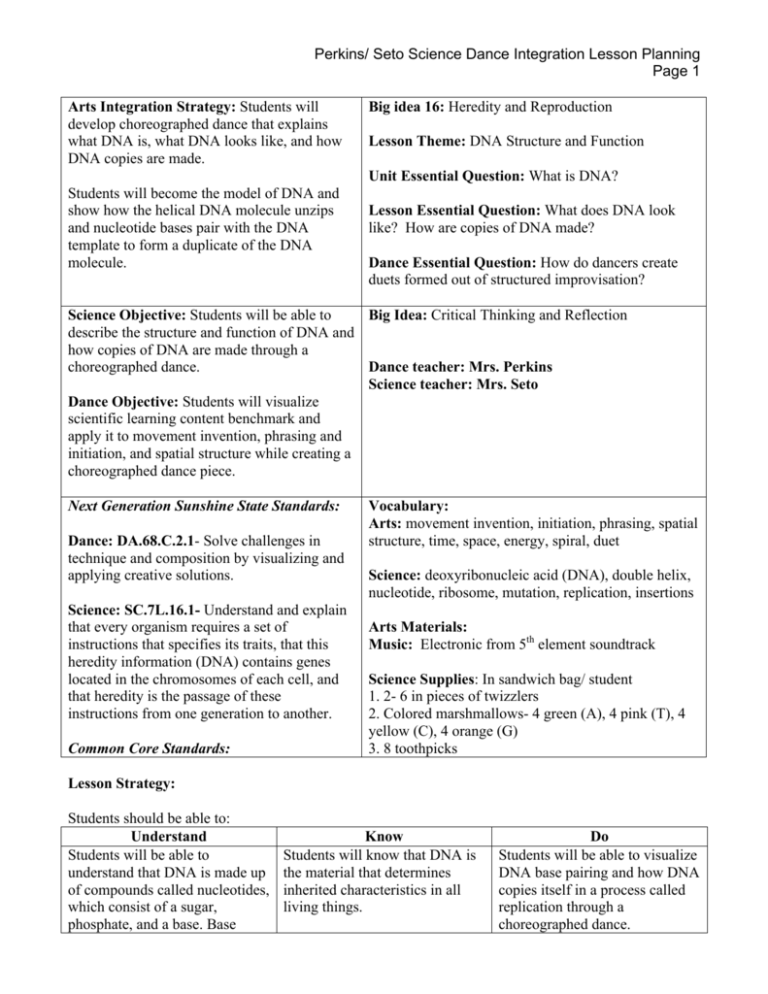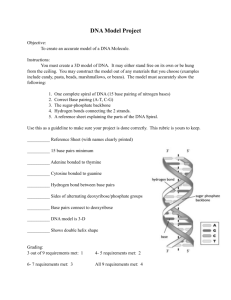Dance the DNA Lesson Plan
advertisement

Perkins/ Seto Science Dance Integration Lesson Planning Page 1 Arts Integration Strategy: Students will develop choreographed dance that explains what DNA is, what DNA looks like, and how DNA copies are made. Big idea 16: Heredity and Reproduction Lesson Theme: DNA Structure and Function Unit Essential Question: What is DNA? Students will become the model of DNA and show how the helical DNA molecule unzips and nucleotide bases pair with the DNA template to form a duplicate of the DNA molecule. Lesson Essential Question: What does DNA look like? How are copies of DNA made? Dance Essential Question: How do dancers create duets formed out of structured improvisation? Science Objective: Students will be able to Big Idea: Critical Thinking and Reflection describe the structure and function of DNA and how copies of DNA are made through a choreographed dance. Dance teacher: Mrs. Perkins Science teacher: Mrs. Seto Dance Objective: Students will visualize scientific learning content benchmark and apply it to movement invention, phrasing and initiation, and spatial structure while creating a choreographed dance piece. Next Generation Sunshine State Standards: Dance: DA.68.C.2.1- Solve challenges in technique and composition by visualizing and applying creative solutions. Science: SC.7L.16.1- Understand and explain that every organism requires a set of instructions that specifies its traits, that this heredity information (DNA) contains genes located in the chromosomes of each cell, and that heredity is the passage of these instructions from one generation to another. Common Core Standards: Vocabulary: Arts: movement invention, initiation, phrasing, spatial structure, time, space, energy, spiral, duet Science: deoxyribonucleic acid (DNA), double helix, nucleotide, ribosome, mutation, replication, insertions Arts Materials: Music: Electronic from 5th element soundtrack Science Supplies: In sandwich bag/ student 1. 2- 6 in pieces of twizzlers 2. Colored marshmallows- 4 green (A), 4 pink (T), 4 yellow (C), 4 orange (G) 3. 8 toothpicks Lesson Strategy: Students should be able to: Understand Students will be able to understand that DNA is made up of compounds called nucleotides, which consist of a sugar, phosphate, and a base. Base Know Students will know that DNA is the material that determines inherited characteristics in all living things. Do Students will be able to visualize DNA base pairing and how DNA copies itself in a process called replication through a choreographed dance. Perkins/ Seto Science Dance Integration Lesson Planning Page 2 pairing occurs between Adenine and Thymine and Cytosine and Guanine as the DNA molecule is made. Engage (hook, demonstration, free write, brainstorming, analyze a graphic organizer, KWL, etc) Bellwork: Students will build an edible model of DNA using materials (twizzlers, colored mini marshmallows, toothpicks) provided in sandwich bag on desk. Green (Adenine) base pairs with pink (Thymine) and yellow (Cytosine) base pairs with orange (Guanine). Students will watch short 2 min animation about DNA. Students will warm up with set modern class: stretching, Horton Fortifications/ Conditioning and Limon Technique. Explore (investigation, solve a problem, collect data, construct model, etc.) Students will move in spiral shape to mimic the movement of the double helical DNA and make duets (base-pairing) through contact improvisations. Students will show how base pairing occurs as they move to pair the nucleotide A with T and C with G. These nucleotides when paired correctly form a lock and key type connection. Students will discuss problems connecting to the original strand of DNA (dancers) and problem solve solutions of the dancer’s movement as it relates to DNA replication and seen as DNA mutations, repetitions, and insertions. Explain (student analysis, structured questioning, reading and discussion, teacher explanation, compare, classify) In two different groups, students will perform structural improvisations based on DNA replication. Each group will analyze the other group and apply each other’s solution to form correct base- pairing of the DNA. Students will see the choreographed movements as a model of the actual DNA replication process. Dancers must use the concepts of draw and attraction to create structure in improvisations. Dance modeling will allow for dance concepts of draw and retreat to be effectively executed. Elaborate/Extend (problem solving, decision making, experimental inquiry, compare, classify, apply) Students will take the improvisations and the repetitions and use this choreography to create the final choreographed dance. Students will observe the other groups and discuss and critique the variations presented. Perkins/ Seto Science Dance Integration Lesson Planning Page 3 Evaluate (any of above, develop a scoring tool or Rubric, performance assessment, produce a product, journal entry, portfolio, etc.) The students will match the base pairs correctly by placing the correct nucleotide with its correct base paired nucleotide of the DNA molecule. This will be observed through the dancer’s costume. The final performance assessment (rubric attached) Exit slip- 1. What is the structure and function of DNA? 2. Outline how copies of DNA are made. 5 question science in-class assessment (attached) References Holt McDougal Science Fusion unit 9, lesson 1 pg. 464-473 Text Reference (s): ABT National Curriculum Guide Intimate Act of Choreography Dance Imagery Electronic Reference s (web sites, Gizmo, other, paste hyper-links or URLs here) Gizmo- Building DNA http://www.explorelearning.com/index.cfm?method=cResource.dspView&ResourceID=43 9&ClassID=1585503 Introduction to DNA http://www.khanacademy.org/science/biology/evolution-and-natural-selection/v/dna DNA animations http://www.hhmi.org/biointeractive/dna/animations.html Lesson Power Point Electronic Attachme nts Handout- “Have your DNA and eat it too” 5 question science in-class assessment Rubric for dance performance Perkins/ Seto Science Dance Integration Lesson Planning Page 4 After lesson completed: Reflections: Ideas to try on other days:







